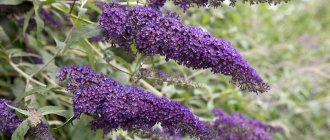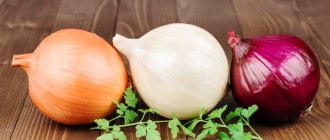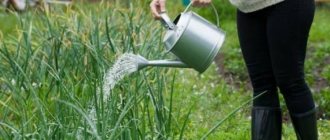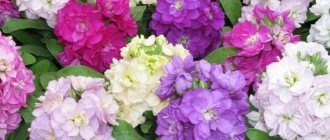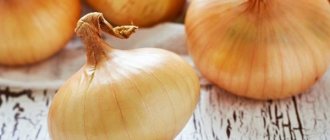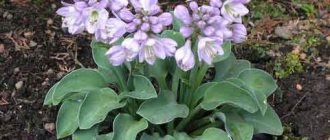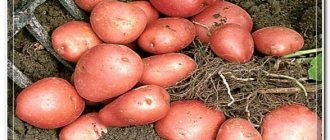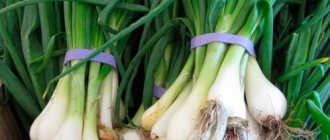Shallots have been grown in our country for a long time, but are still inferior in popularity to their distant relative, onions.
But shallots have many advantages over the varieties we are used to. Dear readers!
For you, we have created communities on social networks in which useful articles and interesting ideas are published several times a day! Subscribe and receive useful content in a convenient format! We will tell you in this article how shallots differ from onions, how to properly grow and store them.
Homeland of shallots and origin and what it looks like
This type of onion is better known among us under the name “family”. Although it is called differently in different parts of the world. You can find the following names: Ashkelon, magpietooth, multilobed, etc.
The Mediterranean region is considered to be the birthplace of shallots, although some botanists determine the place of origin of this vegetable in Palestine, in the vicinity of the ancient city of Ashkelon.
Shallots are several small onions fused together. Hence, by the way, the name “family”. The bulbs themselves are slightly oblong, red-brown in color. In the first year there are usually about 5 of them, but later the number of bulbs increases. After several years of cultivation, a family of several dozen bulbs can gather in one hole.
Landing
Growing shallots begins with preparing the site. This culture is light-loving, so it needs to find a place that is very well lit by the sun. Onions show optimal growth rates with daylight hours of 15-16 hours. With short daylight hours, the crop ripens slowly, and the bulbs are formed of poor quality and are not stored for a long time.
Related article:
Preparing onion sets for planting
Soil requirements
Planting shallots is done in loose, fertile soil. The best precursors for this crop are various types of cabbage, potatoes, legumes, tomatoes and cucumbers. Also, shallots will feel good in an area where green manure (peas, clover, mustard, sweet clover, buckwheat, etc.) previously grew. These plants can be sown after harvesting other crops, mowed and buried in the ground. Thus they become natural fertilizer.
The scanty soil is fertilized in the fall, adding compost or humus under digging at a rate of 3-4 kg/1m2.
The acidity of the soil should be neutral (pH 6-8). In too acidic soil, the feathers begin to turn yellow too early, and the bulbs form small. To deoxidize the soil, dolomite flour (0.5 kg/1m2) or wood ash (1 kg/1m2) is added to it. The procedure is carried out either in the fall or before the start of garden work.
Related article:
Onion sets: secrets of a successful purchase
Spring planting
The sets are placed in uncompacted furrows, spilled with water to a depth of 5-6 cm. The top is covered with soil so that it covers the bulbs with a layer of 2-3 cm. The seeds are sown in furrows 1-1.5 cm deep. The planting material should not be deepened too much, since this may slow down the germination of sprouts. Also, it is necessary to take into account that shallots do not like thickening, so there is no need to plant them in heaps.
Planting before winter
The process of winter planting does not differ significantly from spring planting. The difference is that the planting material is placed a little deeper. In addition, in the future the beds are well mulched with peat or compost. When snow falls, it is poured in a high layer over the area, creating additional insulation.
When choosing winter planting, preference should be given to varieties that are characterized by the highest frost resistance. Their characteristic difference is the level of dry matter content, which should exceed 20%. For example, such varieties include Sir 7 and Siberian Yellow.
Shallot greens after winter planting appear a short period of time after the snow melts in the spring.
The difference between shallots and onions
The most important difference between shallots and onions is that they do not hurt the eyes. It's all about the absence of volatile compounds, which cause irritation of the mucous membranes. By the way, for the same reason, after eating family onions, there is no bad breath left.
Another noticeable difference is the number of bulbs. Onions have one and they are large, while shallots have several and they are small.
These varieties also have taste differences. Onions are spicy, but shallots, on the contrary, are a little sweet. Turnips have almost 2 times lower calorie content.
REFERENCE . Shallots contain much more vitamins (B2, B5, B6, B9) than onions.
The following differences will appeal to summer residents: family onions are stored much better, are more resistant to frost and ripen earlier than their counterparts. The harvest can be obtained already 2.5 months after sowing. But the yield indicators for both species are approximately similar under the same growing conditions.
The flowering is also different. A turnip has 1, maximum 2 arrows, and a family has several feathers with inflorescences.
In terms of benefits, both types have their advantages. Onions are often used for colds and for their prevention. Shallots are useful in reducing blood pressure and for varicose veins.
REFERENCE. Shallots are also preferable for growing “for feathers”, since their flowering period begins later.
Properties of shallots - harm and benefit
Useful properties of shallots
The composition of shallots is not much different from the composition of onions. Shallot leaves and bulbs contain essential oil, B vitamins, carotenoids, phytoncides, but there are more minerals, ascorbic acid and sugars in shallots than in onions. The composition of shallots includes salts of phosphorus, iron, potassium, calcium, as well as cobalt, nickel, chromium, molybdenum, silicon, vanadium, titanium and germanium.
In folk medicine, shallots have long been used to treat stomach and eye diseases.
Leaves and young shallot bulbs are used in cooking, both fresh and pickled. The taste, more subtle than that of onions, has made shallots a valuable ingredient in French cuisine - they are added to sauces and soups to add flavor to dishes, and also added to poultry and game delicacies.
Shallots - contraindications
People with diseases of the genitourinary system and gastrointestinal tract should be careful when consuming shallots, as they increase acidity, can cause irritation of the intestinal mucosa and make urination difficult.
Planting onions before winter and caring for them
Shallots are contraindicated for kidney and liver diseases, bronchospasms, constipation, and pancreatic diseases, as they can cause their exacerbation.
Popular varieties of shallots
Domestic and foreign breeders have developed many varieties of shallots. Among the summer residents of our country, the following varieties of vegetables can be called the most popular.
Banana
A sweet variety that is especially valued by chefs. It has a mild and pleasant taste that does not clog other products and does not leave an unpleasant aftertaste.
Banana giant golden
Large-fruited variety with heads weighing up to 150 g. It has excellent taste and delicate pulp. It is considered one of the sweetest varieties. Great for cooking and keeps well even at room temperature.
Family
Grows up to 15 bulbs. The heads are very small (about 3 cm). The color of the husk is red. Taste without any frills.
Delicacy
It has perhaps the most pleasant taste among all varieties. Onion with a golden tint. The pulp is white and juicy.
Berezovsky aristocrat
A prolific variety. With proper care, you can get about 4 kg of onions per square meter. The variety shows excellent keeping quality and can be stored for up to 3 years. It survives the winter well. It can be planted in autumn. The average weight of one head is about 50 g, the maximum is up to 80 g. In one hole, up to one and a half dozen bulbs grow. The taste is good.
Centipede
It has purple outer scales and whitish inner ones. Gives feathers to greens early. The head is about 10 cm high and 2.5 cm wide.
Knyazhich
Refers to mid-season. The bulbs are elongated, not too massive (a little more than 20 g). About 6-8 heads grow in one hole. Productivity – up to 3 kg. The pulp is light purple, the husk has a reddish tint. It is stored for 9-10 months.
Ryzhik
The bulbs are medium in size, but quite massive (about 60 g). The shape is round, elongated at the top and at the bottom. The color is “classic”, bright red. The pulp is snow-white. It has average taste qualities for shallots, but is characterized by stable yield and resistance to unfavorable conditions.
Friendly family
It is distinguished by its yellowish husk, elongated heads and average weight of fruits. It is one of the most delicious varieties, combining the flavors of both onion and garlic. Popular due to its ease of cultivation.
Istobensky
It has a weighty bulb (up to 150 g). Productivity – 4 kg per 1 sq. m. The husk has a dark, almost purple color. It tastes sweet.
Camelot F1
Popular hybrid with bright red husk. Grows well from sets. Suitable for planting in spring.
Emerald
Early variety. The taste is a little spicy. Rounded bulbs weighing about 20 grams. Color – brownish-pinkish. The pulp is white, juicy. Emerald is stored for almost a year, about 9-10 months.
Earring
Relatively new variety. Grown from sets. The bulbs weigh about 25 grams. The taste is pungent, almost like onions. The husk is yellowish, the pulp is juicy. It is stored somewhat worse than other varieties, only about 8 months.
Variety selection
Shallots and onions are related plants in the Amaryllidaceae family. But in comparison with its “close relative,” shallots are characterized by a number of advantages:
- early ripening (the crop ripens a month earlier);
- frost resistance (in case of severe frosts, the bulbs do not die and remain productive);
- excellent keeping quality (even in apartment conditions the fruits do not spoil for a long time and can be stored until the next harvest);
- high nutrient content.
In addition, gourmets highlight the excellent taste of shallots. It has a pleasant pungent taste and subtle aroma that emphasizes and does not overwhelm the taste of other ingredients in gourmet dishes.
Related article:
How to help onion feathers turn green again
There are many varieties of this culture in the world. The State Register alone contains about 60 varieties. All of them are zoned for any region and differ in the growing season, appearance and taste characteristics. Among the most popular varieties of shallots that are planted in domestic areas are:
| Variety name | Color | Average weight, g | Ripening period | Productivity, kg/1m2 |
| Airat | Juicy scales are white, dry scales are yellow | 15 | Mid-season (80-90 days) | 1.6 |
| Bonilla | Scales yellow-brown | 30-40 | Mid-season (80-90 days) | 1.5 |
| Vitamin basket | Juicy scales are white, dry scales are yellow | 30 | Early ripening (60-70 days) | 1.5 |
| Debut | Dry scales are yellow, juicy scales are white-green | 60-80 | Early ripening (60-70 days) | 2 |
| Family | Juicy scales are white, dry scales are yellow | 20-25 | Mid-season (80-90 days) | 1.5 |
| Siberian yellow | Juicy scales are white, dry scales are yellow | 2020-08-01 00:00:00 | Early ripening (58-73 days) | 1.8 |
| Sire 7 | Juicy scales are white, dry scales are golden with a pink tint | 24-29 | Early ripening (53-71 days) | 2.6-3 |
| Sprint | Juicy scales are white-green, dry scales are golden with a pink tint | 20-26 | Early ripening (60-70 days) | 4.2 |
| Ural purple | Juicy scales are white with a red-violet tint, dry scales are red-violet. | 45 | Mid-season (80-90 days) | 2.6 |
Related article:
Onion: photo, planting and care in open ground
Growing shallots from seeds, or how to grow them in one season
The obvious advantage of Ashkelon onions is the ability to grow them in just one season from seeds. Although this vegetable can also be grown as a biennial plant.
How to choose planting material
When selecting bulbs as planting material, pay attention to the size and external condition. Heads larger than 3 cm are selected for salad greens. It is also important to note that large bulbs will produce more new heads, but they will be much smaller than when planting medium bulbs.
IMPORTANT! The seed must be healthy, without signs of infection or rot.
When selecting seeds, preference should be given to fresh material. Preferably from a year ago. You can select seeds using a saline solution. Dilute a teaspoon of salt in 100 grams of water and wait 10-15 minutes. Those seeds that float can be thrown away. The rest are suitable for growing.
Unlike many other vegetables, when choosing a shallot variety, there is no need to focus on the climate of the region. The plant produces a harvest almost everywhere where vegetable growing is practiced.
How to choose a time to board
Sowing shallots for seedlings is carried out starting in February. You need to choose a specific day based on the lunar calendar for the month.
Unlike most other vegetables grown from seedlings, heirloom onions must be planted during the waning moon.
But it is not worth carrying out work during the new moon and full moon.
In 2021, the most favorable days for sowing onion sets will be:
- In January – 16 – 27;
- In February – 12 – 26;
- In March – 14 – 27;
- In April – 13 – 26;
- In May – 12 – 25.
How to sow shallot seeds
Heirloom onions are planted as sets (that is, bulbs from which other bulbs grow) or seeds. Let's consider both options.
How to plant seedlings
The seedlings must be pre-treated with a fungicide. It is best to take medium bulbs, with a diameter of 2.5 - 3.5 cm. They will give the best harvest.
The planting distance must be chosen depending on the variety. For large-fruited varieties - up to 30 cm, for small ones - up to 10 cm. The average distance between holes is about 20 cm.
Before winter, the holes are made 10 cm deep, and in the spring - 6 cm. It is very important to cover the root collar with at least 3 cm of soil.
How to sow onion seeds
Nigella is sown in fertile, loose soil (universal or for seedlings). Depth – 1 cm. The easiest way is to make grooves and place the seeds at a distance of 4-5 cm from each other.
Next, as with ordinary seedlings, everything is carefully watered, covered with a plastic bag and sent under the radiator until the first shoots appear.
The seeds have sprouted, what to do next?
The first shoots will appear after 1.5-2 weeks. When this happens, the boxes with onions are moved to a bright, but not too sunny place.
How to care for shallot seedlings
Caring for seedlings includes regular watering and loosening the soil. There is no need to be too zealous. Apply water only when the soil begins to dry out. But it is necessary to loosen the soil. This way you will avoid stagnation of water in containers.
How to pick shallots
Picking is an important point in growing shallot seedlings. Before carrying out this, the seedlings must be “trimmed”, leaving about 5 cm above the surface.
Then, carefully digging up and separating the plants from each other, transplant the seedlings into another container. It is not necessary to plant each plant in a separate cup. The point of picking shallots is to thin out the plantings and give the seedlings room to grow.
What to feed
Feeding too frequently will not bring any benefit. It will be enough to apply fertilizer twice. The best fertilizer for onions is ammonium nitrate diluted in water (proportions: 10 grams of substance per bucket of water).
When to plant in open ground
Onion seedlings are ready for transplanting by the third decade of May. First, 15-20 days before the intended planting, you need to dig up the beds and add a mixture of organic fertilizers.
The bed needs to be slightly raised above the level of the rest of the garden. The grooves should be made at a distance of 10-20 cm from each other. The exact distance depends on the variety; keep in mind that the onion family needs space to grow.
ON A NOTE. It is best to plant seedlings in open ground on a cloudy day or early in the morning. Also, for the first time, seedlings need to be shaded from direct sunlight.
Planting shallots before winter
Even despite the good resistance of shallots to severe frosts, it is recommended to plant them before winter in the southern regions. In mid-latitudes the yield will be no more than 50-60%. The plant is sown in the fall to obtain green feathers in early spring and the process begins in mid-October so that the seeds become stronger in the ground, but do not have time to sprout before the first frost:
- The area chosen for crops is cleared of dried grass.
- Compost from rotted leaves or manure is added to the dug up soil and beds are formed at a distance of at least 20 cm from each other.
- There is no need to prepare the seeds; they are simply sown in prepared beds and buried in soil.
- In winter, the sown area is covered with film to prevent the seeds from freezing.
Planting shallots in open ground
Shallots are planted directly into the garden in the fall or spring. For this procedure you will need sevok.
Before winter, planting is carried out in October, and in the spring - immediately after the snow melts. The thing is that this vegetable is not afraid of frost. On the contrary, cold is beneficial for the abundant growth of green mass.
The principle of sowing is no different from the seedling method. The only point is to try not to thicken the plantings. After all, productivity directly depends on this.
ON A NOTE. Onions are sown for greens before winter, and for fruit production - in spring.
Shallots grow relatively quickly, and you will have a harvest in mid-summer.
NOTE! Do not sow different types of onions next to each other to avoid cross-pollination. Plant shallots individually to obtain this particular variety.
Planting and caring for shallots
- Planting: planting in open ground to obtain greenery in May - in March or April, to obtain greenery in April - before winter, in mid-October.
- Lighting: bright sunlight.
- Soil: loose, fertile, moderately moist, neutral reaction. Optimal soils are humus-sandy or humus loams.
- Watering: during the growing season - at least three times. A month before harvesting, watering is stopped. In the absence of precipitation, watering is carried out once a week.
- Fertilizers: organic and mineral. A month before harvest, fertilizing is stopped.
- Reproduction: seed and vegetative (sevcom).
- Pests: onion flies.
- Diseases: powdery mildew, downy mildew (downy mildew), fusarium wilt and neck rot.
- Properties: is a medicinal and dietary plant.
Read more about growing shallots below.
Features of growing shallots
Despite the fact that growing shallots is practically no different from onions, there are several nuances that are worth paying attention to. This will help you get more abundant harvests.
How to choose a landing site
Shallots can be grown in the same beds as regular onions. It also prefers sunlit areas and loose soil. It can be black soil or a mixture of clay soil and sandy soil.
Shallots do not tolerate stagnant water. If your groundwater lies too close to the surface, then you need a drainage system.
ON A NOTE. It is best to create a raised bed.
Suitable predecessors and neighbors for onions
Any representatives of bulbous plants should not be grown in one place for more than 3-4 years in a row.
It is best to alternate them with legumes.
Divide the area into 2 parts. Plant onions on one, peas or beans on the other. Next year, swap crops. You will see that the yield of both legumes and bulbs has increased.
Potatoes, peppers, tomatoes, pumpkin crops and cabbage are also suitable predecessors. But it is not recommended to plant after sunflowers, beets, garlic, corn and carrots.
ON A NOTE. It is better to sow carrots in a neighboring bed so that it wards off the onion fly.
Watering
Onions like moderate moisture. If the summer is not dry, then there is no need to additionally water the plantings. But during prolonged droughts, it is necessary to water the beds at least once every 3 days to prevent the soil from drying out and cracking.
Application of fertilizing and fertilizers
It is better to apply fertilizers before planting onions. If you sow before winter, then you need to take care of this in the last days of August. If you grow spring varieties, you need to apply fertilizers in the fall.
For 1 sq. m of shallot planting requires 3-4 kg of manure, 20 g of superphosphate, 20 g of urea, 80 g of wood ash.
It is not necessary to apply fertilizer during growth. If you are growing onions for greens, you can apply foliar fertilizing with nitrogen fertilizers. They stimulate the growth of green mass.
But if desired, during the growing season you can add superphosphate and potassium chloride to the plant’s diet. It is better to use specialized fertilizer “For onions and garlic”, since all components are mixed in it in the required proportions.
Growing shallots for green feathers
Shallots are perfect for growing green feathers due to their rapid ripening time. The greens are not prone to shooting arrows and remain tender and soft for a long time. Leeks can't even match the profitability of shallots, and they require less seed.
To collect as much green feather harvest as possible, you need to know the following:
- You can grow shallots for pens in open ground, as well as in greenhouses, hotbeds and even on loggias and window sills in pots.
- If you plant the crop at home, then this should be done at the end of February. You will be able to collect the first harvest in a month.
- Once cut, the bulb can be reused. It needs to be removed from the ground, cut off in half and lowered back into the ground. In another month you will receive a second harvest of juicy, healthy greens.
- Onions are planted in open ground at the end of April, and if before winter, then at the end of October. Shallots easily tolerate frost and cold. The first harvest of shallots is also harvested a month later, when the height of the feathers reaches 20-25 cm. This is especially valuable in early spring, when the body lacks vitamins.
When to store shallots
Harvesting is carried out in June-July, depending on the region and varietal characteristics of the onion. In general, it is better to focus not on specific dates, but on the condition of the plant.
Shallots are ready for harvest when more than half of their feathers turn yellow and fall off. In this case, the upper parts of the bulbs should stick out from the ground and be a little harsh. You should not delay harvesting, otherwise the bulbs will begin to sprout again.
After pulling the bulbs out of the soil, dry them thoroughly. In dry summers, onions are left directly in the beds, and in bad weather they are brought under a canopy.
Store onions in a cool, dry (+10 degrees) place in ventilated containers. In villages, onions are often woven into braids and stored, hanging on the walls or under the ceiling.
REFERENCE. The sets are stored in a slightly warmer room (up to 20 degrees).
Features of the variety
There are countless varieties of onions in the world, which are distributed throughout the earth. Some of them are so beautiful that they are used to decorate flower beds or decorate bouquets. And a variety of garden crops - leeks, spring onions, chives, leeks, etc. allows you to choose the one that suits your table. Shallots are far from the last place on this list.
Its popularity is obvious: excellent taste and an easy, quick method of propagation distinguishes this crop from other species, including the familiar onion.
Soft and thin feathers of greenery that do not become coarse for a long time, as well as pleasant and mild in taste, slightly sweetish onions. After eating shallots, there is no specific smell from the mouth, which allows you to use it in any recipe, at any time of the day. When added to hot dishes, it does not interrupt the taste and aroma of other products; small onions are perfect for pickling as a stand-alone preparation or as part of assorted vegetables. And there is also no pain in the eyes and no tears that are inevitable when cleaning and chopping his onion “relative”.
Shallots are also called “family” due to the peculiarities of the formation of the bulbs. Depending on the growing location, weather conditions and varietal characteristics, their number in one nest can sometimes reach 25-30 pieces. Such high productivity even in small beds saves both land area and labor costs for gardeners. A quick method of growing a crop allows you to get the next year's harvest by planting the mother bulbs of the previous year. In addition, shallot feathers retain a pleasant taste for a long period, and bolting occurs extremely rarely, which significantly extends the spring season of vitamin greens.
All characteristics confirm that this garden crop should take its rightful place on your site. And simple growing rules will help you get excellent harvests without much hassle or investment.
Diseases and pests
Despite the fact that shallots rarely get sick and almost do not suffer from pests, some problems are possible if they are not cared for properly.
If you find heterogeneous white stripes on the bottom of the onion, you should know that the set is affected by the onion nematode. Getting rid of it is quite simple: put the onions in hot, but not boiling water, and the pests die. The second way to fight is to soak for 2 minutes in a solution of methanol and formaldehyde.
In addition to nematodes, infection with onion flies or aphids is possible. Carrots planted nearby and wormwood spread between the rows help well against flies. In addition to conventional insecticides, treatment with a solution of hot pepper helps against aphids.
With improper watering, rot and fungal diseases may appear: powdery mildew, fusarium. It is better to destroy the affected plants, and treat healthy ones with fungicides for preventive purposes.
Preparation of planting material
The effectiveness of growing shallots and the hassle of caring for them directly depend on the quality of the planting material. For gardening work, seeds or sets can be used. Planting material can be purchased at gardening stores or made yourself. In any case, it is necessary to take a responsible approach to the issue of the quality of seeds or sets, since the future harvest directly depends on this.
Industrially produced seeds usually already undergo all the necessary processing and before sowing they only need to be soaked in water (or a rooting agent). “Homemade” seeds should be calibrated and treated with a fungicidal agent to prevent the development of fungal diseases.
Related article:
How to treat onions before planting
The seedlings also need to be disinfected by keeping them in water for about 10 hours at a temperature of 40-45 C, or treating them with a fungicide (according to the instructions) or a solution of potassium permanganate (place in the solution for half an hour). It is also necessary to sort through it, discard damaged onions and sort them by size. This is done in order to plan a planting pattern in the garden bed:
- small caliber onions are planted in a row at a distance of 8-10 cm;
- average – 15-17 cm;
- large – 20-25 cm.
The distance between rows should be at least 30 cm.
Answers to frequently asked questions
Which variety of heirloom onion should I choose?
In general, there are special varieties for Siberia, but shallots grow quickly and can be grown from seeds without problems. So take the variety you like.
Which bow is better? Family or onion?
It is impossible to answer this question unequivocally. Both vegetables are healthy and used in cooking. For example, turnips are more suitable for marinades and preparing meat for barbecue, while shallots go well with other vegetables and do not interrupt the taste of the main product.
The best solution to this issue would be to sow both varieties.
What are the features of growing shallots?
In general, none. Just one small detail. In spring, Ashkelon onions should be sown as soon as the snow melts.
Is it possible to collect nigella from onions in the garden?
Quite. Perhaps some qualities of the new plants will not be the same as those of the parent specimens, but can you get a harvest from nigella?
How often should fertilizing be done?
1-2 is enough. In the spring, before planting the seeds and in the summer, during the growing season. Apply organic matter the first time, and nitrogen fertilizers the second time.
How often should heirloom onions be watered?
In a good summer, once every 1-2 weeks. But during a drought, every 2-3 days. If the summer, on the contrary, is rainy, then do not forget to loosen the soil so that the water does not stagnate and rotting does not begin.
Is it possible to plant shallots next to onions?
It is undesirable to do this, as there is a high probability of cross-pollination. What does it mean? You will not get what you planted the family for: delicate taste, absence of unpleasant odor, productivity. It is better to separate the family and turnips by other crops.
How to choose a day to plant shallots?
Focus on the lunar calendar. Plant on the waning moon and under no circumstances work on the days of the full moon or new moon.
Landing dates
Shallots are a perennial plant. The nutritional value in it comes from the bulbs themselves and thin, tender greens. Therefore, the crop can be grown for turnips or “for feathers” throughout the year. The planting period depends on the purpose for which it is grown:
- March-April or the end of October: planted for forcing greens by May, by April - if winter planting was done in the fall;
- April-May (October): sowing seeds to obtain sets, which will be ready for harvesting around July (June);
- the entire winter period: using sets or commercial bulbs at home to obtain greens.
When growing turnips, planting material is planted in open ground when the top layer of soil has warmed up well. In this case, the commercial onion ripens in 70-90 days, depending on the variety, and the greens are ready for consumption much earlier.
Related article:
How to grow large onions and store them until next summer
During winter planting, seeds or sets are planted in mid or late October. This way, the planting material will have time to take root, but will not begin to grow and will be able to survive the winter.
Shallots can be grown in heated greenhouses all year round.
Technology for growing succulent bulbs in one season
Onions are a very popular garden crop that many gardeners grow. Thanks to its beneficial properties and piquant taste, this plant is loved by many. It is consumed fresh and also added to various dishes, snacks and salads. As a rule, in order to get large bulbs, you must first grow seedlings and only in the second year do you get a standard harvest. Now technologies have been developed and varieties have been bred that make it possible to grow onions from seeds - from sowing to harvesting in one season.
Types of onions for seed cultivation
Today, there are many varieties of onions that differ from each other in appearance, taste, specifics of cultivation and features of care. Some varieties are grown for greens, others for spherical bulbous fruits.
The most common onion varieties include the following.
Chives or chives
This plant is native to Eastern Siberia, China and Northern Mongolia. A unique crop that grows in any climatic conditions, it is often used for greens.
- Chives are little known to many, so they are grown in small quantities. This variety is most widespread in Siberia.
- This is a frost-resistant plant, the seedlings of which can withstand temperatures down to -3-4 degrees. Chives are grown for plumes. Given the increased resistance to cold, the greens of this variety can be harvested until the end of December.
- Chives can be grown from seeds or vegetatively. Seeds are planted both in open ground and in a greenhouse. The seeds of this hybrid have high germination rates for two years. They are planted in early spring according to a 50x25 cm pattern. In addition, chives can be sown before winter. It can be grown as an annual, biennial or perennial crop.
- To obtain aromatic and tasty greens, chives are often watered and periodically fed with organic and mineral fertilizers.
- Chives are a perennial herbaceous crop that does not form bulbs. Unlike other varieties, this plant produces a huge number of leaves and forms a powerful root system.
- Chives have high taste qualities and contain vitamin C and carotene.
Shallot
This is an early ripening variety with a delicate and soft taste of medium-sized and very aromatic luovits.
This species is widespread in the North and East of Russia. Today, there are sharp and semi-sharp varieties of shallots. It is grown for feathers and for bulbs. Shallots are a high-yielding variety. In one season, from a plot of 1 m2 you can get up to five kilograms of greens and three kilograms of bulbs.
Growing shallots is carried out using seed children. The ripening time for bulbs from the moment the seeds are planted is about three months. Shallots keep well.
Unlike onions, shallots have a less pungent and more delicate taste. When sown from seeds, shallots form a large number of bulbs in a nest - up to five pieces. Every year their number increases.
If you follow all the rules of agricultural technology, you can already get the first greens three weeks after planting the shallot seeds.
Slime bow
This culture received this name due to the mucus that the leaves secrete when they break.
This crop is grown for feathers, as well as for producing fruits - bulbs. Slime onion is a perennial plant that is grown and propagated by seeds. It is recommended to plant seeds in nutritious soil. Otherwise, you can end up with bitter and unpleasant-tasting greens.
Slime onion is resistant to various diseases and pests. Basic care for this plant includes regular feeding, frequent watering, loosening the soil and removing weeds from the area. The ideal and most harmless fertilizer for onions is ash, which is added during the growing season. The feather is cut off in the second year after planting the seeds. Overgrown greens that have reached thirty centimeters in height lose their taste and become rough. Therefore, it is necessary to cut only young leaves.
Slime onion, like many other representatives of the Onion family, is capable of growing a large number of baby onions, forming large clumps. Therefore, once every five years, the slime onion must be replanted. This plant can be grown even in winter, after transplanting it into a pot. Slime onions grow well at home on the windowsill and produce tasty and juicy greens.
Chalcedony
A mid-season onion variety with a ripening period of 3.5 to 4 months. It is a high-yielding crop that is grown using seeds to produce bulbs. In one season, from a plot of 1 m2 you can get up to five kilograms of fruit. The chalcedony onion harvest is yellow, sharp-tasting, round-shaped bulbs that store well from April to May. Excellent for growing from seeds.
Luke Globo and Exhibition
These are relatively new varieties - giants, mid-season, intended only for seed cultivation. The size of one bulb can reach 1 kg. This is one of the largest salad hybrids. The fruits are sweet in taste and have no specific odor. Globo and Exhibition onions are successfully grown from seeds in open ground through seedlings.
Onion
This is one of our most popular and favorite varieties. An unpretentious, winter-hardy and high-yielding crop, widespread everywhere. Onion batun is a perennial that can grow in one place for up to five years. This plant is mainly grown for its feathers. Instead of a bulb, the onion produces a thickened stem, which is called a false bulb. This crop is propagated by seeds and division of rhizomes.
- The seed growing technology is more popular and effective. The seeds of this onion ripen on a long peduncle, after which they are collected. The seeds do not need to be collected, but given the opportunity to be sown around the bushes.
- Planting of seed material is carried out on nutritious and well-lit soil. This plant produces a large number of leaves, so it needs space to grow fully. Batun onion seeds are planted at a distance of fifteen centimeters from each other, the distance between the rows is maintained at least half a meter.
- The feather is cut off for the first time at the beginning of May. Batun onion produces very tasty and aromatic greens, which can be cut several times in one season. In the fall, cutting of greenery is stopped to allow the plants to prepare for winter.
- Some gardeners grow onion as an annual or perennial crop. Annual seeds are planted at the end of April. Already at the beginning of September you can get the first harvest of juicy and tasty leaves.
- At the end of July, two-year-old onions are planted. Before the onset of cold weather, the seedlings must germinate and become stronger. Next year, from mid-summer to early October, you can enjoy tasty and juicy greens from your garden.
- Batun onion is resistant to drought, frost and various diseases, for which it is valued by many gardeners.
Leek
A very popular crop, ranking third among all representatives of the Onion family.
The technology for growing this variety is based on the use of seeds. Planting material has high germination rate, which lasts for three years. Before sowing, the seeds undergo special treatment. They are disinfected by immersing them alternately, first in hot and then in cold water. To achieve earlier germination, the seed material is germinated before planting. The seeds are laid out on damp gauze and placed in a warm place for three days. For ease of sowing, they are slightly dried. This procedure is carried out for seeds collected on their own site. There is no need to germinate purchased seeds.
The seeds are sown in the second half of May.
Winter growing of leeks from seeds
Growing leeks from seeds before winter is a little different. This method is more effective for regions with cool climates. To obtain seedlings, seeds can be sown at the end of February in special boxes or in mid-April under film on the site. If planting is carried out in winter, then the plants need to be provided with twelve-hour daylight and a temperature range of 23-25 degrees. For successful germination, seedlings are covered with a transparent film until they germinate.
- As soon as the first shoots appear, the shelter is removed and the temperature is lowered to seventeen degrees. After a week, the temperature is raised to twenty degrees.
- The correct temperature is the key to obtaining a good and high-quality harvest. If the seeds are planted in peat tablets or peat humus pots, then in the future they will not need picking.
- Compost tea is an ideal food for this plant. To develop the root system, it is necessary to periodically trim the grown greenery at a level of ten centimeters.
- Before planting, seedlings undergo adaptation to new growing conditions. It is periodically ventilated. Leeks are planted in fertile soil according to a 15x25 cm pattern in the month of May. Compost or rotted manure is placed at the bottom of each hole. Before planting, the leaves and root system of plants are shortened by a third.
- This plant is very demanding on watering and soil fertility, especially during the growing season. Typically, leeks are fertilized with a solution of bird droppings in a ratio of 1:20. You can also use mullein, previously diluted in water in a ratio of 1:8.
- Leeks can be planted together with carrots, alternating the planting ridges. This crop will protect onion plantings from onion fly invasion. Leeks go well with strawberries, celery and beets.
The productive value of this variety is its false stem.
The feather is not suitable for human consumption. With good care, this part of the plant can reach fifty centimeters in length and four centimeters in diameter. This is a frost-resistant plant. Adult specimens successfully tolerate temperature drops down to -6-7 degrees. In mild climates, leeks can overwinter under snow. During the rainy and cold season, the plants form short and thin stems. Growing onions from seeds is a painstaking but rewarding process. With good care and the right growing conditions, you can grow any variety and get a good harvest of fragrant greens and large bulbs.
LetovSadu.ru
Shallot breeding methods
Shallots are grown in a variety of ways. The method is chosen taking into account what part of the plant the gardener wants to collect and how quickly:
- Growing from sets. Sets are called miniature bulbs. They are sown in spring or autumn. In one season, large onions are obtained, ready for harvest.
- Seed cultivation. In the first year, this method allows you to obtain greens and seedlings for planting. Only a year after planting will the gardener be able to collect the formed shallot bulbs.
- Seedling method. If you sow shallot seeds as seedlings, you will be able to harvest large bulbs at the end of summer. To get seedlings by the end of spring, they are sown in early April.
Harvesting
Harvesting of shallots begins when 60-70% of its leaves become dry. Dig the bulbs in dry, sunny weather. They are taken out of the ground and dried together with the “feathers” in the sun for two weeks. After this, the leaves are cut off, leaving only the upper tip 3-4 cm high.
The harvest is stored in boxes in a dry room. It lasts the longest at t = 0...+3 C. It can also be kept at room temperature. However, in a hot room, its quality and nutritional properties rapidly deteriorate.
Varieties of wild crops
The following varieties of wild onions are popular among gardeners:
- Branched. Sometimes the variety is called mountain or Chinese garlic. The foliage is flat, but at the same time succulent and erect. The main feature of this variety is the taste of garlic, which is mixed with onion. Greens are suitable for consumption from mid-summer until the first frost. The green feather continues to grow until autumn. But the onion itself is not eaten.
- Victorious. A distinctive feature is the higher, oval-shaped pouring. It grows throughout Russia, including the Far East, as well as in Europe.
- Bearish. In appearance it bears little resemblance to the usual onion, but it is one.
It grows most often on mountain slopes and forests. The bulbs grow small, only 1 cm in diameter. But the stem can reach up to 50 cm in height. The foliage is oval-shaped, up to 5 cm wide, flat in structure. The base of the leaf blade and the top of the bulb are purple. The spicy taste is not so pronounced. Used in the autumn to replenish vitamins in the body. It is advisable to cut greens before the foliage opens, then they become tough. - Aprior. Refers to mid-season varieties. The first greens can be cut at the end of May. The bush is characterized by high branching. It has a high content of vitamin C.
- Particularly popular is a variety called Piquant. Characterized by juicy soft greens and resistance to frost. Also rich in vitamins.
Methods for planting shallots and onions
Planting shallots in ribbons is convenient for plant care and provides sufficient lighting and good ventilation. The distance between the tapes is 70 cm, there are 4 rows in one tape. A distance of 20 cm is maintained between the rows. In a row, the distance between the bulbs is 9–10 cm. After planting, the rows are mulched with peat. The planting material is planted in pre-watered soil so that the distance from the soil level to the shoulders of the onion is from 2 to 4 cm. Processing shallot plantings is not difficult; the rows need to be weeded and loosened in a timely manner. Water the bulbs during drought.
There are other options for planting the plant; caring for shallots depends on the climatic conditions of the area and the type of planting material. The bulbs are embedded in the ground to a depth of 6 cm, the layer of soil above it should be at least 2 - 3 cm. Planted in early spring in still cold soil (up to 10 ° C). Unheated soil stimulates root growth. A powerful root system allows the plant to gain strength. If you are late with planting, then in warm weather the growth of leaves will outpace the rate of formation of the root system, and the weakened plant will be defenseless against an army of pests and diseases.
Types of shallots
Varieties of shallots, like other vegetables, are divided according to their ripening periods into early, medium and late.
Shallots also differ in taste by variety:
- semi-sharp;
- spicy;
- sweet.
Below are popular varieties of shallots, grouped by ripening time.
Early
The most popular types:
- Belozerets 94. Round bulbs weighing 20-30 g. Color – light lilac. The taste is spicy.
- Vitamin basket. Bulbs with a spicy taste. The color of the scales is yellow. Weight – 30 g.
- The star is white. Round and round-flat bulbs of bright white color. The taste is spicy. Weight – 50-70 g.
- Grasshopper. Round-flat elongated bulbs. The scales are lilac-red. The taste of onions is sweet and spicy. The weight of one bulb is up to 70 g. It forms very large nests, weighing up to 220 g. Excellent keeping quality - can be stored until a new harvest. The feathers are delicate, with a pleasant aroma.
- Golden Gourmet. English high-yielding variety with a semi-sharp taste. Can be stored for up to 14 months. The bulbs are oval-elongated. The length of the bulbs is 7 cm. Dry scales are brown, juicy scales are yellow, with a delicate taste. The weight of the nest is up to 150 g. The weight of one bulb is 40-70 g.
- Cascade. The bulbs are broadly ovoid in shape. Dry scales are pink, juicy scales are white. Weight – 35 g. Shelf life: 7 months. The taste is delicately sweet.
Mid-season
The most popular mid-season varieties:
- White penguin. The weight of the bulbs is up to 80 g. There are 6 bulbs in one nest. The color of the scales is white. The taste of the pulp is sweet and spicy. The shape is round-oval, length – 4-5 cm, diameter – 3 cm. Stored for up to 8 months. The feathers are delicate, light green.
- Guarantee. Peninsular variety. The bulbs are round-flat. One nest contains 4-10 bulbs. Weight – 20-30 g.
- Miner. Onions with a semi-sharp taste. The bulbs are round. There are 5-7 onions in one nest. Yellow color.
- Firebird. A semi-sharp variety with round-flat bulbs. Scales are yellow-brown. Weight of bulbs – 30 g.
- Albik. Peninsular variety. The bulbs are yellow, weighing up to 30 g. The shape of the bulbs is transversely elliptical. The variety is characterized by high keeping quality.
- Guran. Onions with a semi-sharp taste. Round bulbs with light brown scales. Weight of bulbs – 25 g.
- Veliky Ustyug. Large, brown-red bulbs weighing up to 80 g. The nest contains 6-10 g. The variety is very productive. The taste is spicy.
- Kuban "Kvochka" yellow. A variety with large sweet-spicy bulbs. The nest consists of 5-10 bulbs. Dry scales are brown-yellow, juicy scales are milky yellow. Forms powerful feathers 30 cm high. The bulbs are elongated, oval-flat in shape. Weight – up to 120 g.
- Kuban "Kvochka" red. Features high productivity. The bulbs are elongated, rounded and flat. Dry scales are brown-red, juicy scales are white-violet. The taste is sweet and spicy. Weight – up to 100 g. The rosette is spreading, the height of the feathers is 30 cm.
Late
The most popular varieties:
- Sturdy. Onions with a semi-sharp taste. Oval bulbs with pink scales. There are up to 7 onions in the nest. High keeping quality. Resistant to rot and bolting.
- Ural purple. The scales are reddish-violet. Weight – up to 60 g. Taste – semi-sharp.
- Siberian amber. A semi-sharp variety with round-flat yellow-bronze bulbs. Bulb weight – 30 g.
- Kunak. Onions with a semi-sharp taste. The bulbs are round, slightly flattened. The scales are light yellow, with a brownish tint. There are 3-4 segments in the nest.
- Marneuli. Georgian variety. The bulbs are elongated-oval. Scales are pink-yellow. There are an average of 5 lobules in a nest. The taste is sweet. Shelf life: 1 year. It has high productivity.
The sweetest of the entire onion family is the banana shallot. The variety is early ripening and cold-resistant. Very tasty onions that do not overwhelm the flavors of other foods. Prized by gourmets. Unlike regular shallots, the banana variety has larger bulbs.
Preparing shallots for planting
To grow shallots, it is important to create optimal conditions for their growth. Preparatory work is carried out in advance. Not only the seed material is prepared, but also the soil.
When to plant
The timing of planting shallots is determined not only by the region, but also by the time when the gardener wants to get the harvest. Planting material is sown in early spring or late autumn.
Planting onions before winter is used only in southern regions, such as Belgorod, Crimea, Sochi, Krasnodar, and Astrakhan region. Planting material is sown at the end of October or beginning of November. In order for the onion to take root, at least 3 weeks must pass from planting to frost.
Shallots are a cold-resistant crop. Onions are sown already in the first half of April.
Experienced gardeners advise taking into account the indications of the lunar calendar.
Favorable days for planting shallots in 2021:
| Month | Favorable dates | Unfavorable dates |
| March | 8, 10, 16–19 | 9, 20–21, 24 |
| April | 5–7, 9–15, 17–22, 27–30 | 8, 14–16, 23 |
| May | 2–6, 9, 11–12, 20–21, 29–31 | 7, 13–14, 22 |
| June | 7–9, 11–14 | 5, 8–10, 22 |
| July | 4, 6, 9–11, 13–16, 27–29 | 5, 7–8, 20 |
| August | 5–10 | 3–4, 19, 31 |
| September | 24–26 | 1–2, 17, 27–28 |
| October | 3–6, 8–11, 13–15, 18–23, 26–28 | 2, 16, 22–25 |
| November | 5–9, 22–24 | 15, 20–22, 30 |
Days not listed in the table are also suitable for planting. During this period, the Moon does not have a significant effect on the bow.
To view a complete overview of growing onions in practice:
Place and soil for planting
For shallots, choose the most sunlit, open areas of the garden. No other representatives of the Onion family should grow in the chosen location for the past three years.
The best precursors for shallots are legumes, nightshade, pumpkin, cabbage, and cruciferous crops. It is useful to plant them next to each other. This will increase protection against diseases and pests.
Shallots love loose, nutritious neutral soil. If the acidity of the soil is increased, add ash or dry lime.
The site is prepared at least 3 weeks before planting. It is dug up, cleared of weeds, and fertilizers are applied at the rate of 6 kg of humus, 20 g of potassium salts, 30 g of superphosphate per 1 sq. m. m.
Fertilizers are mixed with the soil, dug again, then leveled with a rake. 2–3 days before planting onions, water the soil with a hot solution of copper sulfate (1 tablespoon of the product per bucket of water) at the rate of 10 liters of the product per 1 square meter. m.
Seed preparation
To protect shallots from infection, as well as to increase the germination of planting material, preparatory work is carried out before planting.
How to properly prepare shallots for planting:
- Calibration The bulbs are sorted, removing all damaged, rotten and stained specimens. The finer the planting material, the longer it will take to germinate.
- Disinfection. The seedlings are immersed in a light pink solution of potassium permanganate or “Fitosporin” for 10 minutes.
- Growth stimulation. Planting material is soaked for 2–3 hours in a growth stimulator, for example, Epin.
If seeds are not used for planting, they are germinated in advance. To do this, planting material is disinfected, soaked in a growth stimulator, and then wrapped in a damp cloth, placed in any container and placed in a warm place.
How to cook or eat shallots?
Chopped shallots make an excellent base for sauces. Shallots are used to prepare hot dishes – they add a delicate taste.
Finely chopped shallots are used as a seasoning when roasting meat and cooking kebabs.
Shallots go well with meat, fish, vegetables, and poultry.
Control of pests and diseases of onions
Many people know that cold and damp weather often precedes the plant being affected by a fungus (powdery mildew, downy mildew, fusarium and neck rot).
To prevent infection of healthy plants, it is important to remove diseased crops at the first sign. Healthy onion feathers should be sprayed with solutions: Quadris, Pentophage or Mikosan.
It is worth taking into account that after adding these drugs, onions will not be eaten for some time. The instructions for any of the products will indicate the duration of action of the chemical fertilizer.
To avoid the appearance of fungal diseases, you can treat onions with Maxim before planting. It is recommended to treat seeding bulbs that will be sown next year with the same.
One of the most annoying pests for shallots is the onion fly. It usually appears when cherry and dandelion trees begin to bloom. If a fly infects plants, the process of rotting and withering of the crop begins. You can get rid of the pest by spraying the onions with ash. If small worms appear, the onion should be treated with a mixture of water and salt: 1 tbsp. for 10 l.
Without exaggeration, the onion nematode can cause enormous harm to the plant. The disease bends the bottom of the mother's bulb. If an infected bulb is planted next to healthy plants, then no harvest can be expected - it will infect all healthy crops. Before planting infected seed, it is necessary to treat for an hour with hot water at about 45 °C or treat the seedlings in a Formalin solution.
Onion greens, like other plants in the garden, are loved by aphids. If its presence is not controlled, it will affect all the plants in the garden. There are enough natural methods to combat this pest (without the use of chemical additives).
Spraying with chamomile, decoctions of potato peels and pepper is often practiced. There are some commercial pest control products that do not harm the human body, including the drug Verticillin. It is acaricidal and fights this problem well.
Photos of wild onion varieties
The photo below shows some varieties of wild onions:
Variety Branched (Jusai)
Variety Pobedny
Variety Bear
Feeding
In the process of caring for shallots, 2 additional feedings are performed during the growing season. The first application of fertilizers is carried out when the plant has formed 2-3 leaves. The beds are watered with a solution of urea (1 tablespoon per 10 liters of water) or bird droppings (0.5 liters per 10 liters of water), or other fertilizer that contains nitrogen. You can also use an infusion of weeds to water the beds. To prepare it, pour half a bucket of cut grass with a bucket of hot water and leave for two weeks. After which the concentrate is diluted with water 1:10. In addition to nitrogen-containing fertilizers, mineral mixtures with potassium and phosphorus are used.
Related article:
Your onion harvest is guaranteed
The second feeding is carried out approximately 14 days later. By this time, plants usually have 5 leaves already formed. Now onions require potassium and phosphorus to a greater extent than nitrogen. Therefore, it is necessary to use complex mineral fertilizers (for example, potassium monophosphate), which are diluted in water or embedded in well-moistened soil.
To improve the quality of the crop, seedlings are also thinned, and during the period of bulb ripening (approximately July), “unliquid stock” is removed. To do this, dig up the plant a little and break off small bulbs in the nest along with the feather. This will make the remaining bulbs larger.
If the shallots form an arrow, it must be cut off at the base before it reaches 10 cm in length.
Propagation by seeds
When planning to grow shallots in a summer cottage, you should resort to the method of propagating the plant by seeds. The landing process in this case will be slightly different. Furrows up to 3 cm deep are made in the ground, into which the seeds are placed. For rapid germination, the grains are first kept in damp gauze. The grooves need to be filled with peat or organic fertilizers.
Growing onions from seeds is significantly inferior to the vegetative propagation method, because shallot grains often ripen and sprout poorly.


